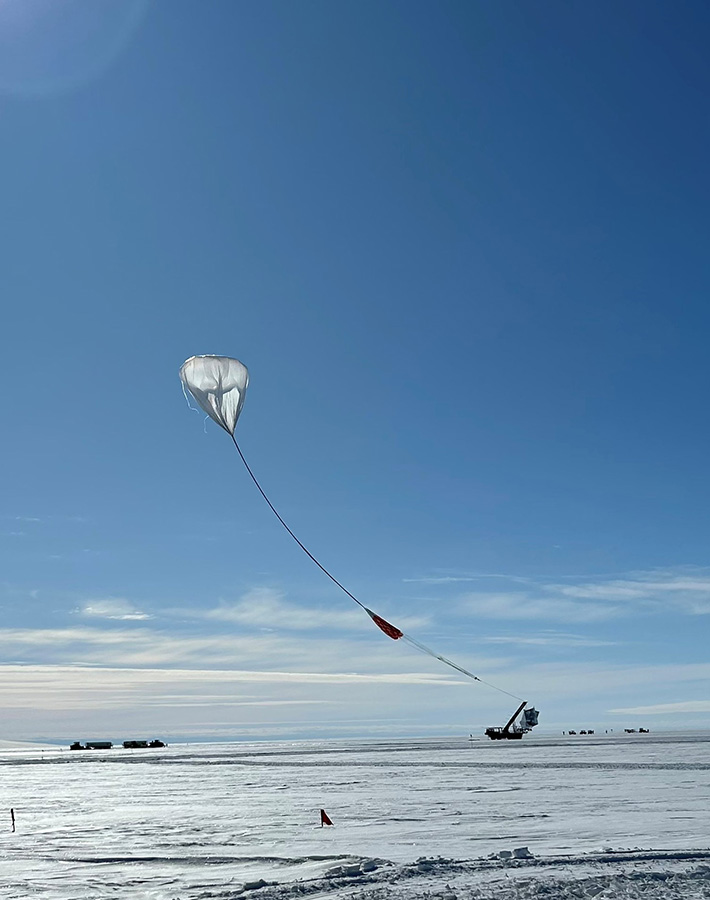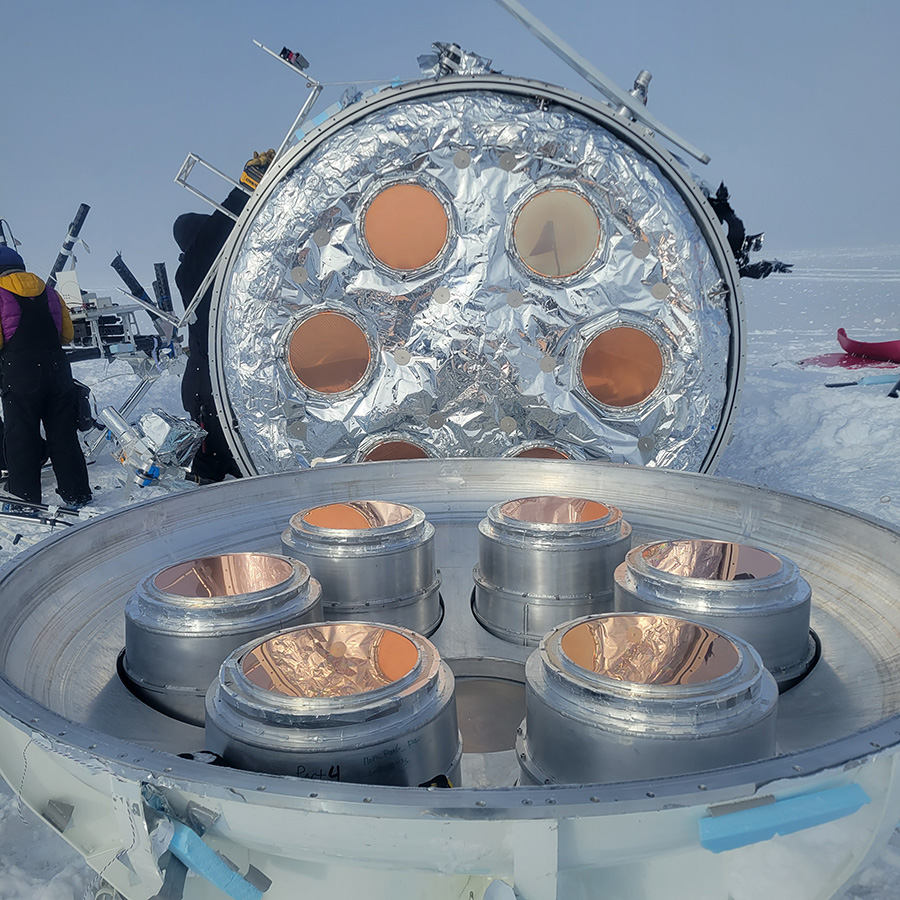|
The SPIDER instrument launches from the Long-Duration Balloon Facility outside McMurdo Station. Balloon-borne telescopes take baby pictures of the cosmosInstruments launched from Antarctica capture the oldest light in space, giving scientists clues to how the universe expanded in its earliest daysMarch 6, 2023
The SPIDER instrument has finished its 16-day voyage through the stratosphere above Antarctica, completing the second and final flight of its mission to search for evidence of gravitational waves from the earliest moments of the universe. 
Image Credit: Lauren Lipuma.
The SPIDER team finalizes preparing the craft's sun shield inside a launch hangar bay at the the Long-Duration Balloon Facility.
SPIDER launched from McMurdo Station's Long-Duration Balloon Facility on the morning of December 22, 2022. It was McMurdo's only balloon mission launched this austral summer season and the first launch from the facility in three years. Operated by NASA with support from the U.S. Antarctic Program, the Long-Duration Balloon Facility uses enormous helium balloons to lift instruments into Earth's stratosphere. It's a way of launching payloads into near space without the use of a rocket. The balloon-borne instruments fly at around 120,000 feet (36.5 km) and stay aloft for 10 to 20 days on average, allowing scientists to study the sun, the universe, and the space environment. SPIDER's payload is an array of six telescopes designed to study the cosmic microwave background radiation, or CMB: the oldest light in the universe. SPIDER's flight ended on January 7, and U.S. Antarctic Program support staff recovered the payload and hard drives from where they landed during the last two weeks of January. Researchers hope SPIDER's data will provide evidence of gravitational waves, or ripples in spacetime, created by the Big Bang. This would help scientists better understand the history, structure, and origins of the cosmos. “[The CMB is a] universe-sized detector that we can look at with our instrument and try to tease out the signature of whether those gravitational waves were there,” said Jeff Filippini, a physicist at the University of Illinois at Urbana-Champaign and principal investigator of the SPIDER project. “If we see that, we learn truly unique information about the universe's first instants and what set in motion all the things we see around us.” The oldest light in the universeThe early universe was a hot, dense, glowing plasma-like “soup” - not unlike the surface of the sun. But by about 370,000 years after the Big Bang, the universe had expanded and cooled enough for atoms to form. At this point, light waves could travel freely through space for the first time, and the universe became transparent (as it is today). 
Photo Credit: Jeff Filippini.
The balloon carrying the SPIDER instrument is released so that it floats directly above the payload before launch.
The glow given off by that early plasma is the oldest light in the universe, and those light waves have been traveling throughout the cosmos ever since. They are observable now as the cosmic microwave background radiation: the light is no longer visible to the naked eye, but has been stretched by the universe's expansion into the spectrum of microwaves and radio waves. “If you build a sufficiently sensitive instrument, you can see this glow permeating all of space, in every direction, that gives you a direct picture of the early universe: it's a baby picture of our cosmos,” Filippini said. Interestingly, physicists studying the CMB for some time have noticed that its light is polarized, and SPIDER analyzes that polarization pattern. “Polarization is about the orientation of light waves. Think of looking through polarized sunglasses: the view you see changes slightly depending on how you tilt your head,” Filippini said. “Our instrument makes a polarized map of the sky… you can see not just a brightness, but a degree and direction of polarization associated with each point in the sky.” That polarization pattern can provide evidence of primordial gravitational waves from the Big Bang. Those gravitational waves would give scientists information about the very earliest moments of the universe - mere fractions of a second after the Big Bang. “The idea is in the very, very, very earliest moments, the universe went through a period of very rapid expansion, and that should have left a sort of noise of gravitational waves: ripples in spacetime,” Filippini said. “They're incredibly faint, but they should be visible as a particular pattern of polarization in the cosmic microwave background.” Taking baby pictures of the cosmosSPIDER's six telescopes pick up the polarization pattern of the CMB. To capture this faint light signal, the telescopes are cooled to a fraction of a degree above absolute zero and the payload is built to keep its back to the sun during the entire flight. 
Image Credit: Luke Haberkern.
The SPIDER payload is recovered by U.S. Antarctic Program support staff.
SPIDER was designed as a two-flight mission, and its first launch was on New Year's Day 2015. That first flight lasted 17 days, and scientists used its data to set an upper limit on the brightness of these primordial gravitational waves. “We did not see them, but we set a strict constraint on how bright they can be,” Filippini said. The payload from SPIDER's first flight was recovered in November 2015, and many of those components were used to build the instruments for its second flight. But the latest SPIDER spacecraft is slightly different than its first iteration: this time, researchers added telescopes specifically designed to observe galactic dust. “We have three new telescopes that are specifically designed to observe galactic dust… which will help us tease out the difference between the primordial signal we're looking for and the dust, which could fake that signal,” Filippini said. Launch and recoveryMcMurdo Station is an ideal place from which to launch long-duration balloons. During the austral summer, air currents in the upper atmosphere keep balloons on a roughly circular trajectory over Antarctica, preventing them from going out to sea. This means instruments can fly around the continent several times (if winds allow) and the payload can be recovered when the flight is over. 
Photo Credit: Luke Haberkern.
A view of SPIDER's telescopes after the craft landed near Hercules Dome.
The SPIDER team spent the summer of 2022 preparing and testing their payload for its second and final flight. After shipping it to Antarctica and assembling it at the Long-Duration Balloon Facility, they went through the arduous task of using liquid helium to cool the telescopes down to nearly absolute zero. Once the right weather conditions lined up, the balloon and payload were launched on Thursday, December 22. The balloon, filled with millions of liters of helium gas, carried SPIDER upward to the stratosphere in a matter of hours. At that altitude, the balloon expands to 34 million cubic feet - big enough to encompass an entire football stadium. SPIDER's balloon flew westward around the Antarctic continent for 16 days, then was brought down on January 7. The balloon and payload landed at Hercules Dome, a spot roughly 270 miles from the geographic South Pole between East and West Antarctica. U.S. Antarctic Program support staff recovered the SPIDER payload and hard drives that recorded its data in January. Once the drives return to the United States, researchers can begin analyzing data from the flight. Even if SPIDER's data doesn't show evidence of primordial gravitational waves, physicists will still have gained valuable information about the origins of the universe, according to Filippini. “Even not seeing them tells you which models of the universe are not true,” he said. “So you're learning something, even if you don't discover it. Learning the ways the universe isn't is very important.” |
"News about the USAP, the Ice, and the People"



For USAP Participants |
For The Public |
For Researchers and EducatorsContact UsU.S. National Science FoundationOffice of Polar Programs Geosciences Directorate 2415 Eisenhower Avenue, Suite W7100 Alexandria, VA 22314 Sign up for the NSF Office of Polar Programs newsletter and events. Feedback Form |

